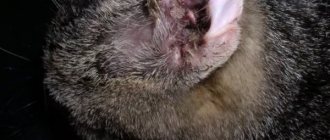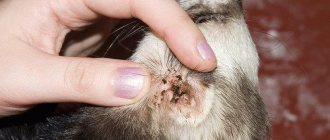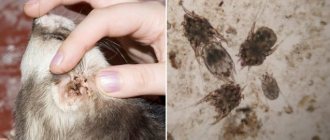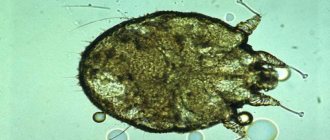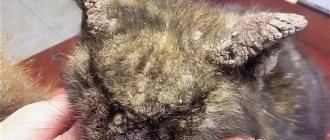12703Administration
Otodectosis is a very unpleasant disease caused by the appearance of ear mites in an animal. It happens quite often in pets, mainly cats and dogs. Other animals also suffer from it - for example, foxes and other fur-bearing animals. The question of whether ear mites in cats are dangerous for humans worries many owners who have encountered the disease in their pet.
What a parasite is, how an animal is infected, what symptoms are typical, and whether the disease is transmitted to humans is important to know for everyone who has dogs or cats in their home.
general information
In cats, both ears are usually infected, because... The animal itself transfers the parasite when washing from the diseased ear to the healthy one. Symptoms of infection soon appear and the pet experiences discomfort.
First sign
Once in the ear, the parasite eats away the skin and mucous tissue.
The cat suffers from severe itching, scratches continuously, and shakes its head.
How to spot a tick
It is difficult to see a tick with the naked eye, but you can identify it by its characteristic signs: brown discharge with an unpleasant odor accumulates in the cat’s ear canals. These are waste products of microscopic pests.
At the veterinary clinic, ear exudate is analyzed under a microscope. Using optics it is easy to detect parasitic arthropods.
What do parasites eat?
Pests feed on skin, blood, lymph, and ear secretions (wax). By burrowing under the skin, the parasites actively multiply and gnaw their passages right in it.
Numerous lesions in which waste products of mites accumulate, become inflamed, irritate the nerve endings, and cause itching.
Discomfort
The animal experiences itching and unpleasant sensations when mites penetrate the layers of the skin, gnawing and injuring them. Painful sensations develop later when otitis media develops.
Consequences of improper treatment
If the animal is treated at home using traditional methods or the situation is completely abandoned, the inflammation will penetrate into the middle ear and otitis media will develop. The disease will become chronic and the cat may lose hearing.
Is the animal contagious?
Cat ticks are not transmitted to humans. The parasite is not dangerous for either adults or children. These pests, like fleas, do not parasitize the human body, but can cause allergic reactions.
The owner of a sick pet is a carrier of otodectosis and is contagious to other animals.
The disease is transmitted from an infected individual to dogs, rabbits, and guinea pigs. Kittens most often suffer from this infection.
Where do ticks come from?
The parasite is not always transmitted from a sick individual to a healthy one; it can be brought into the house on the shoes of the owner.
If stray cats live on the landing of an apartment building, the infection will easily penetrate the apartment and the pet will suffer. Fleas, lice eaters and flies are also carriers of the infection.
Routes of infection
Cats, dogs, rabbits, ferrets, birds, and rodents can suffer from otodectosis.
The most common ways cats become infected with ear mites are:
- Upon contact with a sick animal. In cities, the main carriers of otodectosis are pigeons. Those pets that are not outdoors can become infected at exhibitions or in veterinary clinics.
- When in contact with things of an infected animal: carrier, bedding, comb. Most often, this spread path can be traced in a house where several pets live.
- Through the owner's shoes and clothing, on which the parasite is brought into the house from the street.
Symptoms of the disease
Finding out that your pet is infected is quite simple. The disease has characteristic symptoms that are not similar to other diseases. During their life, mites secrete saliva and feces, which cause severe itching and irritation on the skin.
Symptoms of otodectosis:
change in behavior: the cat shakes its head, tilts it to one side, becomes restless, meows, rubs its ears against protruding surfaces;- the appearance of dark, foul-smelling discharge from the ear, pus;
- dark (brown) flaky crusts form inside the ears, it looks like dried blood.
The inside of a healthy animal's ear is always clean and odorless. Normally, the discharge is light yellow in color. The appearance of thick masses in the form of dirt, blood, pus is a clear sign of infection.
Ignoring treatment
If there is no treatment in the early stages of infection, the inflammation penetrates into the ear, as the animal constantly scratches it, abrasions and wounds form. Microbes enter them and a secondary infection occurs.
As a result, otitis media is diagnosed, and in advanced cases, inflammation of the meninges. In this case, the pet’s body temperature rises, it throws its head to the side, and seizures occur.
The consequences of neglected otodectosis are sad: the animal dies.
What are ear mites?
The ear mite (Otodectes cynotus) is a fairly close relative of the spider, a small arthropod belonging to the class of parasites. It usually chooses dogs and cats as “hosts,” causing them to develop a dangerous disease called otodectosis (popularly known as ear scabies). Ticks like the warm and moist environment inside the animal's ear - they settle there, becoming a source of mechanical irritation and provoking inflammatory processes. Ear mites in cats are not a death sentence, but if you are faced with a cat ear mite problem, treatment is necessary, otherwise you may lose your pet.
What does an ear mite look like in cats?
This insect is pale yellow in color with an oval body of uneven contour up to 0.6 mm long. If you suspect a disease, you can carefully insert a cotton swab into the securely fixed animal's ear and remove several parasites along with their waste products. By placing the stick on a dark surface, you can see and find out with your own eyes what ear mites are in cats; Photos of this harmful insect are presented in abundance on the Internet, and comparing these pictures and what you get from a cat’s ear is a matter of just a few seconds. If your vision leaves much to be desired, it is recommended to use a magnifying glass.
Diagnostics
The first suspicions may arise from an observant owner. It is enough to carefully monitor your pet’s behavior and examine its ears. Itching, scratching the ears with paws, and the presence of brown plaque inside the ear canals indicate infection.
Examination by a veterinarian
Before going to the veterinary clinic, the cat’s ears are not cleaned. The accumulated contents will be needed for analysis.
In a clinical setting, the doctor examines the affected area with an otoscope. The instrument allows you to assess the condition of the inner and middle ear, eardrum. Ear discharge is taken for examination under a microscope, after which an accurate diagnosis is made.
Comments
I bought a British cat. At home we noticed that the kitten began to constantly scratch his left ear. It got to the point where he started scratching until it bled. A veterinarian was called to the house. The veterinarian gave me a tick injection, and two weeks later I got a second one. A brown, viscous liquid began to come out of the kitten's ear. I constantly cleaned my ear with a sponge. Now we constantly use special oil and drip it into our ears. It is not recommended to use frequent injections against ticks, as this will cause damage to the animal’s liver.
My cat once had ear mites. He really scratched his ears until they bled, and the inner surface of his ears was black in tiny dots. I immediately took the cat to the veterinarian, they prescribed drops against ticks, which stung a lot, and emollients. I had to drip for two weeks and also clean my ears. He also ran away and hid from treatment. But they cured him. Domestic cat, apparently picked up a tick on a shoe. It's good that it worked out.
I take my cat to the vet about once every year or a year and a half, if there is nothing bothering me, for preventative purposes, just in case. I have never had a tick, although I don’t take any emergency measures, the only thing is that I don’t have contact with stray animals, I don’t hide or treat shoes and street things in general. Could it be that there are ticks but they don’t bother the cat? Blackness in the ears has appeared for about a month, the cat behaves as always.
We adopted a cat from the shelter already infected with otodecosis. Having never had anything to do with this, we ourselves treated her for this ear mite. The symptoms were really obvious. Unpleasant smell, often scratched ears with paws, bald patches appeared
In addition, because the shelter did not pay attention to her illness, she developed a complication in the form of purulent otitis media. It was then that I learned for the first time that cats, like people, can have a very high temperature, it was literally burning
We quickly decided to inject her with an antibiotic. Thanks to this, she remained alive and now delights us with herself and her games.
Treatment
It is important to remember that you cannot self-medicate. Therapy is prescribed only by a veterinarian in accordance with the diagnosis .
Why self-medication is dangerous
In the process of improper treatment, a secondary infection may occur, which significantly worsens the situation. The animal may lose hearing or die.
Ear rinsing
At the first stage, the cat's ears are washed with antiseptics. For these purposes, specialized drugs Atomin and Auricap are used. You can also wash the affected area with hydrogen peroxide (2% solution), Rivanol (0.1%), Furacilin, Boric acid (3%).
Antiseptics are injected into the ear with a syringe without a needle under pressure. As soon as the liquid softens the crusts, they are cleaned off with a gauze swab. Movements should be careful, in the direction from the inside of the ear to the outside.
Rinsing is necessary to cleanse the affected area and facilitate the penetration of medications.
Medications
The following drops cope well with the disease: Amitrazine, Tsipam, Aurikan. The drugs are instilled into both ears, even if there is inflammation in only one.
The dosage and treatment regimen are prescribed by the veterinarian. It is important to strictly follow the recommendations: acaricidal drugs are toxic and can harm the animal.
As soon as the drops have entered the ear canal, it is massaged from the outside of the ear: this way the active substance penetrates inside faster and its effect is more effective.
Oridermil, Aversectin ointment, Vedinol, Amidel-gel are used for treatment.
These drugs are applied only with ear sticks or cotton swabs, carefully spreading the product over the auricle. After this, the ear is massaged at the base for better effect of the ointment.
Ointments with sulfur are effective against ear mites: Vishnevsky ointment, colloidal sulfur. These drugs are prescribed as auxiliary drugs.
After the ear has been washed with an antiseptic, you can use special anti-mite powders, for example Ektosan, Barrier. They are poured into the ear according to the instructions.
Sprays (Fipronil, Auricap) are effective for otodectosis. The product is sprayed into the ear for a few seconds. The affected areas are treated especially carefully with the drug.
If the animal reacts violently to the injection of drugs into the ear, you can use the products on the withers. Frontline, Stronghold, Bars - drops that effectively destroy mites and their eggs without insertion into the ear canal.
The dosage of drugs is calculated according to the weight of the animal.
Treatment is carried out for 5–7 days. A week later, the treatment is repeated to destroy the second generation of parasites.
When an inflammatory process develops in the ear canals, antibiotics are prescribed. They effectively cope with infection.
Therapy and care
Many people are interested in how to treat ear mites in cats if there are other animals in the house? First, you need to isolate the sick person from other animals, throw out all bedding, rugs and other textiles on which the cat was located from the house. The apartment is thoroughly washed with disinfectants. The treatment of a sick animal is carried out wearing gloves and clothing that is not taken out of a closed room or closet.
The main rules for treating ear mites in cats include the following:
- If there are several furry inhabitants (cats or dogs) in the house, then everyone will have to be treated - regardless of whether they have the disease or not. For kittens and pregnant animals, it is worth using a gentle spray.
- Don’t forget about careful cleaning of your home. It is better to throw away bedding and rugs, or, as a last resort, boil them.
- It is worth remembering that a pet’s recovery directly depends on the strength of its immunity. Provide the patient with balanced, high-quality food and include vitamins in the diet.
- Clean your home more often. Remember that harmful microorganisms settle on various objects, in cracks in the floor, in fabrics and even in books.
- Never use products containing ethyl alcohol to treat ear mites in cats.
The duration of treatment for ear mites in cats will depend on the degree of neglect of the disease and on the drugs chosen. Simple cases can be resolved in one to three weeks. But in case of complications, when there is a secondary infection, the treatment process will drag on for several months.
Hygiene procedures and processing
All medications will be prescribed by a doctor. He will also tell you about the treatment regimen. Further actions will be approximately as follows:
- First of all, the surface of the ears is cleaned of crusts and dried particles, and the hair that gets in the way is trimmed.
- Warm hydrogen peroxide is carefully and slowly injected using a syringe. 2-3 ml is enough. You have to wait 15 minutes. You can replace this substance with olive oil.
- Using tweezers and a cotton swab, carefully clean out all the secretions. Dirty swabs are placed in a closed container. After completing the manipulations, they must be burned.
- After the ear canal has been thoroughly treated, 1-2 ml of acaricidal liniment or solution prescribed by a veterinarian must be administered, heated to 32 degrees (slightly warmer than room temperature).
- The auricle is bent and a small massage is given for about five minutes.
- Acaricidal powders are blown into each auditory organ or special aerosols and drops are used.
Such manipulations are repeated three times every week, but the exact schedule of procedures will be drawn up by a veterinarian. External cleaning of the ears is carried out daily.
Drug treatment
There are various medications for ear mites in cats, produced in Russia and abroad. The most popular are ointments for ear mites in cats or drops. There are also sprays that can be used to treat bedding, the cat’s body and its “personal items”. The ointment has the longest working time, but it is not as easy to apply as drops or spray. What remedies for ear mites in cats in the form of drops does modern pharmacology offer:
1. Amitrazine
. It is quite popular because it has a triple therapeutic effect: it destroys infections, fungal infections and subcutaneous pests. The substances begin to act immediately after instillation. This option is considered less toxic. The positive thing is that there are no negative effects.
2. Otoferonol
. This option is similar to the previous one. This is an excellent substance for ear mites in cats. Drops have low toxicity. They are comfortable and safe to use for treating kittens. It is only important to dose and apply the substance correctly. This drug must be injected into two hearing organs at once, even if only one is damaged.
3. Tsipam
. The medication has no side effects or contraindications. If the intervention is started in a timely manner, the treatment can be carried out only once. If the disease is advanced, you will have to repeat the manipulations every week until the condition finally improves.
4. Drops Bars
. They are instilled directly into the auditory organ, 3 ml each. If purulent inflammation is present, the dosage is increased. The areas need to be treated for seven to ten days intermittently. However, side effects often occur due to individual sensitivity.
Use ointment as an aid. The doctor will prescribe Aversectin ointment, Amidel-gel. Vedinol Plus, Ordermil.
Acaricidal powders are also used in veterinary medicine
:
- Phenothiazine
. It has a light yellow tint and a weak specific odor. The substance has a strong acaricidal, antimicrobial and anthelmintic effect. The drug is low-toxic and can be stored in closed packaging for quite a long time without losing its properties.
- Fine sulfur.
Light yellow powder that is insoluble in water. It should be used as part of a set of measures when infected with mites or fungi. The product can be purchased at any veterinary pharmacy, the drug is widely available.
A small dose of powder is poured into the hearing organ using paper. The advantage of the powder is its uniform distribution, the disadvantage is that it is quite difficult to apply. If your cat does not tolerate treatment procedures well, it is best to stop with drops.
Radical methods of therapy include the special antiparasitic drug Ivermectin, which is administered subcutaneously. The instructions contain the exact dosage, calculated based on the weight of the animal. This substance is very toxic, so it is prohibited for use outside veterinary clinics. It should not be used for small kittens, pregnant or weakened animals.
If otodectosis is advanced and signs of meningitis appear, then antibiotics, immunomodulatory elements, and vitamins are used for treatment. Such a “severe” patient is usually admitted to a hospital.
Folk remedies: useful and dangerous
At the first signs of otodectosis, you can try using folk remedies. In this case, it is necessary to carefully monitor the entire process so as not to prolong the disease. Before starting home therapy, be sure to consult with a veterinarian - you can call the veterinary clinic and agree on treatment measures over the phone.
Popular options include almond butter and strong green tea. They are used to treat mite-affected areas. It is important to observe personal hygiene measures here: carry out all manipulations only with special gloves. It is worth doing the procedures regularly, otherwise they will not give results.
All products must be fresh and at a comfortable temperature. To do this, they are slightly heated.
It must be remembered that some folk remedies for ear mites in cats can cause harm rather than benefit. For example, some owners prefer to use soda or crushed garlic, but they can lead to poisoning. Even worse is to use celandine, since it is extremely toxic not only to pests, but also to animals.
To avoid harming your pet, consult your doctor about each decoction or drug. Ideally, folk remedies should be combined with medications - only then the treatment will bring quick and positive results.
Prevention
Treatment for otodectosis is simple, but the disease itself causes suffering for the pet. The owner needs to take care to prevent infection of his beloved cat.
Eliminating unwanted contacts
A pet should not walk unattended on the street or come into contact with outdoor cats. They are the carriers of parasites. It is better not to let a pet living in a city apartment go outside at all.
Regular inspection
It is recommended to inspect your cat's fur and skin weekly for lesions and parasites. You should also look in your ears to make sure they are clean.
If exudate appears, it is removed with a cotton swab. If there is copious foul-smelling discharge, contact a veterinary clinic.
Hygiene
Ears are cleaned regularly as they become dirty. If the procedure is carried out rarely or completely ignored, then the risk of inflammatory ear diseases increases, and mite infection may simply not be noticed .
Ear cleansers
Cotton swabs moistened with hydrogen peroxide or Furacilin are suitable for cleansing. You can also use special products for cleaning cats' ears. They are sold in pet stores.
Such specialized hygiene lotions are safe even for kittens and pregnant cats, and are a good preventive measure against ticks and other infections.
Such products as Veda phytohygiene, Bars, Tevua, Cytoderm have proven themselves. Some of them contain chlorhexidine, medicinal plant extracts, and medicinal oils.
Are ear mites dangerous for humans?
For humans, ear mites, fortunately, do not pose a danger, so if a pet has picked it up somewhere, there is no need to worry that it will infect its owners and their children.
But other pets - cats and dogs, as well as ferrets - will be under a real threat of further spread of the parasite, therefore, so that a single case of ear mite disease does not develop into an epidemic within a separate apartment, for the entire duration of treatment you should follow the rule: isolate the sick animal from healthy, and also keep them away from his bedding and toys. In addition, it is strongly recommended that all pets be checked by a veterinarian to see if tick infestation is already an established fact. If the infection has spread, the animals should be treated at the same time. If the infected cat is a nursing mother, the kitten may also have parasites - you will need to show it to a doctor and decide whether it should be taken away from its mother and, if so, how to provide it with nutrition.
